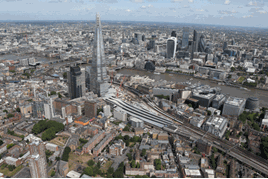London Bridge station is one of the oldest in the world. It started life in the 1830s as a terminus, built on cleared land on the south bank of the Thames. Land was cheaper there, and it was easier to evict the non-voting poor than the wealthier residents north of the river.
For some time, the site featured a jumble of stations all belonging to different companies. The London and Greenwich Railway built its first station in 1836. Then the London and Croydon Railway built its own station next to it in 1839, when the London and Greenwich sold it enough land to pay for its own viaduct.
The architect Lewis Cubitt (of King’s Cross fame) then designed a new joint station, which opened in 1844. Eventually the London, Brighton and South Coast Railway (LBSCR) and South Eastern Railway (SER) managed to combine the buildings into two large joint stations. The LBSCR had the terminus, while the SER station served the through lines to the west.
In the 19th century, London Bridge was renowned for being a confused and confusing mess. Platforms weren’t numbered sequentially in the two stations, and it wasn’t always obvious how passengers were supposed to find their way around the vast complex of arches, tunnels and offices.
The Southern Railway took control in 1923, and started introducing colour light signals, new signalling equipment, and third rail electrification in the 1930s. The SR also upgraded the shabby Victorian station and concourse to the best of its ability, although the heavy restrictions on space made it difficult to make any real impact.
It was still an under-capacity, chaotic place in the 1940s. It was heavily damaged in 1943 during the blitz, and was repaired as best the Southern Railway could manage.
Most of the termini in London have been in a state of constant upgrading and reinvestment since they were built, and London Bridge is no exception. In the 1970s, British Rail decided that it was time for another upgrade at the station, to cope with increasing passenger numbers against a backdrop of insufficient capacity and pathing issues.
And so in 1972 a major resignalling and upgrading programme began. The Victorian trainshed was retained over the through lines, but a new set of awnings was built across the SER tracks, and the station received a new concourse.
The work was finished in 1978 and cost approximately £21 million, and was widely praised by architects and civil engineers at the time as one of the best station rebuilds of the 20th century.
It proved sufficient for the station to cope with the traffic demands of the day, but eventually it was always going to need further serious upgrading. The trackwork at London Bridge is predictably dense, and has caused bottlenecking issues ever since the first decades of its existence.
This will soon be upgraded and flows improved, although the problems of operating a major, busy station in such cramped conditions may well reappear even after rebuilding work is completed. It’s a problem at many other stations in similar situations, notably the eastern station throat at Manchester Piccadilly.
Visit London Bridge in the 1980s, and you were likely to see an abundance of Class 415 and ‘419’ electric multiple units trundling along. The ‘space age’ footbridge, built as part of the 1970s upgrades, would also have been there - in all its brown, incongruous splendour. The bridge is now being demolished as part of the new upgrades.
Following the Southern’s electrification of London Bridge, EMUs became a common sight on suburban and coastal services. In fact, the third rail EMUs are still there, although they’ve come a very long way since the slam-door Mk 1 bodies of the 1960s, 70s and 80s.
London Bridge is still used for commuter services and suburban trains around London and the South East, and is busier now than at any time in its history.
Today’s units are Govia Thameslink Railway services to the South Coast, whizzing through in the form of Classes 317 and 319. GTR Class 377 Electrostars and Class 456s are also frequent visitors en route to the likes of Brighton, Caterham, Tadworth.
Southeastern trains travel through to Cannon Street and Charing Cross, and in the other direction serve Hastings, Dartford and Hayes. These take the form of Class 367, ‘465’ and ‘466’ EMUs.
Controversially, Southeastern uses Driver Only Operation (DOO) on its routes out of London Bridge. Many of its services are listed as DOO, although they remain the exception (rather than the rule) at London Bridge.
Soon we will also be able to see new Desiro City Class 700 EMUs at London Bridge, on Thameslink services.
Today’s plans for the station also include complete renewal of the interior, incorporating some of the Victorian arches and passageways into a newly designed concourse. The viaduct leading to the station itself is being cleaned, renovated and partly rebuilt, to allow for new track and layouts at the throat that will make it a more efficient through station with fewer terminal platforms.
This all gives the impression of a station in continuous development. There’s plenty still being done to improve London’s veteran through/terminus, and it’s all being done while the trains still rumble through and passengers still crowd the concourses.















Login to comment
Comments
No comments have been made yet.